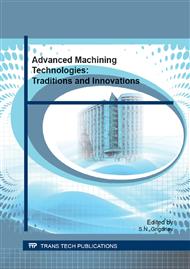[1]
N. Al-Aqeeli, N. Saheb, T. Laoui, K. Mohammad, The synthesis of nanostructured WC-based hardmetals using mechanical alloying and their direct consolidation. J Nanomaterials (2014).
DOI: 10.1155/2014/640750
Google Scholar
[2]
H. Attar, M. Bonisch, M. Calin, L-C. Zhang, S. Scudino, J. Eckert, Selective laser melting of in situ titanium-titanium boride composites: Processing, microstructure and mechanical properties. Acta Mater (2014).
DOI: 10.1016/j.actamat.2014.05.022
Google Scholar
[3]
D. Gu, Y-C. Hagedron, W. Meiners, K. Wissenbach, R. Poprawe, Nanocristalline TiC reinforced Ti matrix bulk-form nanocomposites by Selective Laser Melting (SLM): Debsification, growth mechanism and wear behavior. Composites Sci Technol (2011).
DOI: 10.1016/j.compscitech.2011.07.010
Google Scholar
[4]
P. Krakhmalev, I. Yadroitsev. Microstructure and properties of intermetallic composite coatings fabricated by selective laser melting of Ti-SiC powder mixtures. Intermetallics (2014).
DOI: 10.1016/j.intermet.2013.11.012
Google Scholar
[5]
A.V. Gusarov, M. Pavlov, I. Smurov. Residual stresses at laser surface remelting and additive manufacturing. Phys Procedia (2011).
DOI: 10.1016/j.phpro.2011.03.032
Google Scholar
[6]
Li Q, Danlos Y, Song B, Zhang B, Yin S, Liao H. Effect of high-temperature preheating on the selective laser melting of yttria-stabilized zirconia ceramic. J Mater Process Technol (2014).
DOI: 10.1016/j.jmatprotec.2015.02.036
Google Scholar
[7]
R.S. Khmyrov, S.N. Grigoriev, A.A. Okunkova, A.V. Gusarov. On the possibility of selective laser melting of quartz glass. Phys Procedia (2014).
DOI: 10.1016/j.phpro.2014.08.117
Google Scholar
[8]
A.V. Gusarov, I.S. Malakhova-Ziablova, M.D. Pavlov. Thermoelastic residual stresses and deformations at laser treatment. Phys Procedia (2013).
DOI: 10.1016/j.phpro.2013.03.164
Google Scholar
[9]
X.C. Wang, T. Laoui, J. Bonse, J.P. Kruth, B. Lauwers, L. Froyen. Direct selective laser sintering of hard metal powders: Experimental study and simulation. Int J Adv Manuf Technol, (2002).
DOI: 10.1007/s001700200024
Google Scholar
[10]
A.V. Gusarov, I. Yadroitsev, Ph. Bertrand, I. Smurov. Model of radiation and heat transfer in laser-powder interaction zone at selective laser melting. J Heat Transfer (2009).
DOI: 10.1115/1.3109245
Google Scholar
[11]
H.S. Hasan, M.J. Peet, J.M. Jalil, Bhadeshia, HKDH. Heat transfer coefficients during quenching of steels. Heat Mass Transfer (2011).
DOI: 10.1007/s00231-010-0721-4
Google Scholar
[12]
I. Yadroitsev, A. Gusarov, I. Yadroitsava, I. Smurov. Single track formation in selective laser melting of metal powders. J Mater Processing Technology (2010).
DOI: 10.1016/j.jmatprotec.2010.05.010
Google Scholar


